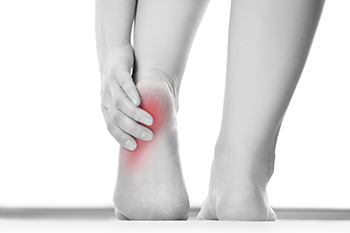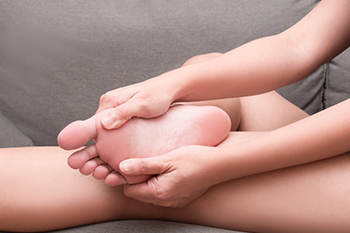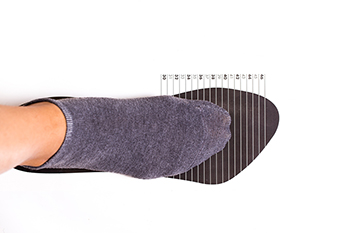
Blog (871)
Heel Pain in New Shoes

Heel pain is never fun, and unfortunately, it can affect people from all walks of life. Many individuals may notice they can experience pronounced heel pain shortly after beginning to wear a new pair of shoes. It is generally important to remember that a good pair of shoes ought to feel comfortable and fit well when you purchase them. By wearing orthotic devices, however, an individual may be able to overcome the possible heel pain which sometimes comes from a new pair of shoes. Specifically, there are certain supportive shoe insoles that can mitigate any potential heel pain you may be experiencing. If you are someone that typically struggles with heel pain or are noticing this type of pain after wearing a new pair of shoes, please schedule an appointment with a podiatrist today.
Many people suffer from bouts of heel pain. For more information, contact one of our podiatrists of Westland Foot & Ankle Specialists, P.C.. Our doctors can provide the care you need to keep you pain-free and on your feet.
Causes of Heel Pain
Heel pain is often associated with plantar fasciitis. The plantar fascia is a band of tissues that extends along the bottom of the foot. A rip or tear in this ligament can cause inflammation of the tissue.
Achilles tendonitis is another cause of heel pain. Inflammation of the Achilles tendon will cause pain from fractures and muscle tearing. Lack of flexibility is also another symptom.
Heel spurs are another cause of pain. When the tissues of the plantar fascia undergo a great deal of stress, it can lead to ligament separation from the heel bone, causing heel spurs.
Why Might Heel Pain Occur?
- Wearing ill-fitting shoes
- Wearing non-supportive shoes
- Weight change
- Excessive running
Treatments
Heel pain should be treated as soon as possible for immediate results. Keeping your feet in a stress-free environment will help. If you suffer from Achilles tendonitis or plantar fasciitis, applying ice will reduce the swelling. Stretching before an exercise like running will help the muscles. Using all these tips will help make heel pain a condition of the past.
If you have any questions please contact our office located in Westland, MI. . We offer the newest diagnostic and treatment technologies for all your foot and ankle needs.
Sesamoiditis Tips

If you have sesamoiditis, you might feel some kind of inflammation in the ball of the feet. This condition occurs when the two sesamoid bones (located in the ball of the feet) become inflamed. If you think that you might have some form of sesamoiditis, consider scheduling an appointment with a podiatrist. Upon your visit, your podiatrist will be able to treat your condition and/or provide you with tips to mitigate it. For example, your podiatrist might recommend that you wear certain specific supportive footwear while exercising. Specifically, your podiatrist might recommend wearing a foot pad underneath the ball of the feet to support the sesamoid bones while working out. Additionally, depending on your condition and your regular exercise routine, your podiatrist might recommend that you maintain a healthy balance between high and low impact activities during exercise routines. Contact a podiatrist today for more information.
Sesamoiditis is an unpleasant foot condition characterized by pain in the balls of the feet. If you think you’re struggling with sesamoiditis, contact one of our podiatrists of Westland Foot & Ankle Specialists, P.C.. Our doctors will treat your condition thoroughly and effectively.
Sesamoiditis
Sesamoiditis is a condition of the foot that affects the ball of the foot. It is more common in younger people than it is in older people. It can also occur with people who have begun a new exercise program, since their bodies are adjusting to the new physical regimen. Pain may also be caused by the inflammation of tendons surrounding the bones. It is important to seek treatment in its early stages because if you ignore the pain, this condition can lead to more serious problems such as severe irritation and bone fractures.
Causes of Sesamoiditis
- Sudden increase in activity
- Increase in physically strenuous movement without a proper warm up or build up
- Foot structure: those who have smaller, bonier feet or those with a high arch may be more susceptible
Treatment for sesamoiditis is non-invasive and simple. Doctors may recommend a strict rest period where the patient forgoes most physical activity. This will help give the patient time to heal their feet through limited activity. For serious cases, it is best to speak with your doctor to determine a treatment option that will help your specific needs.
If you have any questions please feel free to contact our office located in Westland, MI. . We offer the newest diagnostic and treatment technologies for all your foot and ankle needs.
Obesity and Diabetic Foot Care

Due to a particular person’s background, they may be at an increased risk of experiencing poor foot health. For example, individuals who are obese or overweight are one such category of people. Patients living with diabetes make up another category. However, when an individual is both obese and diabetic, they assume a comparatively large amount of risk for developing some kind of foot affliction. Obese diabetics may have poor foot health if they do not take proper measures because their chance of experiencing peripheral neuropathy is higher than the average individual. Additionally, obese diabetics are also more likely to experience peripheral arterial disease, which may also be damaging. If you are someone who struggles with both obesity and diabetes, it is strongly suggested that you contact a podiatrist who can help you manage these conditions. Schedule an appointment with your podiatrist today.
Diabetic foot care is important in preventing foot ailments such as ulcers. If you are suffering from diabetes or have any other concerns about your feet, contact one of our podiatrists from Westland Foot & Ankle Specialists, P.C.. Our doctors can provide the care you need to keep you pain-free and on your feet.
Diabetic Foot Care
Diabetes affects millions of people every year. The condition can damage blood vessels in many parts of the body, especially the feet. Because of this, taking care of your feet is essential if you have diabetes, and having a podiatrist help monitor your foot health is highly recommended.
The Importance of Caring for Your Feet
- Routinely inspect your feet for bruises or sores.
- Wear socks that fit your feet comfortably.
- Wear comfortable shoes that provide adequate support.
Patients with diabetes should have their doctor monitor their blood levels, as blood sugar levels play such a huge role in diabetic care. Monitoring these levels on a regular basis is highly advised.
It is always best to inform your healthcare professional of any concerns you may have regarding your feet, especially for diabetic patients. Early treatment and routine foot examinations are keys to maintaining proper health, especially because severe complications can arise if proper treatment is not applied.
If you have any questions please feel free to contact our office located in Westland, MI. . We offer the newest diagnostic and treatment technologies for all your foot and ankle needs.
Wounds That Don't Heal Need to Be Checked
Moisturizing Your Feet

As part of everyday foot care, moisturizing the feet is important. Start with washing and drying your feet well each day. To prevent dryness, itching, and cracking, incorporate a foot moisturizer into your routine. Wear and tear and the weather can take a toll on the feet and dryness and cracking on the heels can be unsightly. Since cells reproduce more slowly as one ages, the problem is worse in the elderly. Moisturizing the feet can be soothing and also good for the feet. You can buff away dry, dead skin with a pumice stone a few times a week and use moisturizing foot creams daily to keep the feet healthy. If you would like more information on taking good care of your feet, contact a podiatrist who can answer any questions you might have.
Everyday foot care is very important to prevent infection and other foot ailments. If you need your feet checked, contact one of our podiatrists from Westland Foot & Ankle Specialists, P.C.. Our doctors can provide the care you need to keep you pain-free and on your feet.
Everyday Foot Care
Often, people take care of their bodies, face and hair more so than they do for their feet. But the feet are a very important aspect of our bodies, and one that we should pay more attention to. Without our feet, we would not be able to perform most daily tasks.
It is best to check your feet regularly to make sure there are no new bruises or cuts that you may not have noticed before. For dry feet, moisturizer can easily be a remedy and can be applied as often as necessary to the affected areas. Wearing shoes that fit well can also help you maintain good foot health, as well as making it easier to walk and do daily activities without the stress or pain of ill-fitting shoes, high heels, or even flip flops. Wearing clean socks with closed shoes is important to ensure that sweat and bacteria do not accumulate within the shoe. Clean socks help to prevent Athlete’s foot, fungi problems, bad odors, and can absorb sweat.
If you have any questions please feel free to contact our office located in Westland, MI. . We offer the newest diagnostic and treatment technologies for all your foot and ankle needs.
Are You Wearing Shoes That Are Too Small?

Wearing shoes that are too small can cause serious health problems. As one ages, the arch of the foot falls and feet flatten and spread. This often requires wider and maybe longer shoes. If the edges of the shoes can be felt with the toes, the shoes are probably too tight. There should be plenty of room for the toes to move freely inside the shoes. Shoes should be purchased near the end of the day as the feet tend to swell as the day goes on. If shoes rub or pinch any part of the foot, they are likely too small as well. Most people do not really know their accurate shoe size as they do not often have their feet measured and different brands and models of shoes differ in size. Make sure to have a professional measure your feet and provide options if your feet are different sizes. It is recommended that the shoe size fit the longer foot. If you want to make sure you are wearing shoes that fit well and are best for your feet, consult with a podiatrist who is an expert in everything related to feet and ankles.
Getting the right shoe size is an important part of proper foot health. Seek the assistance of one of our podiatrists from Westland Foot & Ankle Specialists, P.C.. Our doctors will provide the care you need to keep you pain-free and on your feet.
Getting the Right Shoe Size
There are many people who wear shoes that are the incorrect size, negatively affecting their feet and posture. Selecting the right shoes is not a difficult process, so long as you keep several things in mind when it comes to choosing the right pair.
- When visiting the shoe store, use the tools available to measure your foot.
- Be sure there is ‘wiggle room’. There should be about an inch between your toes and the tip of your shoes.
- Do not always assume you are the same size, as manufacturers run differently.
- Purchase shoes later in the day, as your feet swell as the day progresses.
- If a shoe is not comfortable, it is not suitable. Most shoes can’t be ‘broken in’, and comfort should be the ultimate goal when it comes to choosing the right pair of shoes
As our feet hold our body weight and keep us moving, it is important to treat them right. Picking the right pair of shoes can provide your feet comfort and mobility without pain.
If you have any questions, please feel free to contact our office located in Westland, MI. . We offer the newest diagnostic and treatment technologies for all your foot care needs.
How to Properly Diagnose Sever’s Disease

Children who frequently participate in sporting activities may be prone to developing Sever’s disease. It is a condition that affects the growth plate in the heel in children and young teenagers, and limping is a noticeable sign. The foot grows to its full size during early puberty and often grows faster than the surrounding tendons and muscles. The foot can become less flexible and can cause extra pressure where the Achilles tendon connects to the heel. A diagnosis that is referred to as the squeeze test is often performed, which is done by squeezing both sides of the heel. Flexibility may be limited, and it may be painful to walk. Effective prevention methods can include having your child wear shoes that have additional cushioning in the heel area, and performing specific stretches that can strengthen the heel. If your active child has heel pain, please consult with a podiatrist who can accurately diagnose Sever’s disease, and offer correct treatment options.
Sever's disease often occurs in children and teens. If your child is experiencing foot or ankle pain, see one of our podiatrists from Westland Foot & Ankle Specialists, P.C.. Our doctors can treat your child’s foot and ankle needs.
Sever’s Disease
Sever’s disease is also known as calcaneal apophysitis, which is a medical condition that causes heel pain I none or both feet. The disease is known to affect children between the ages of 8 and 14.
Sever’s disease occurs when part of the child’s heel known as the growth plate (calcaneal epiphysis) is attached to the Achilles tendon. This area can suffer injury when the muscles and tendons of the growing foot do not keep pace with bone growth. Therefore, the constant pain which one experiences at the back of the heel will make the child unable to put any weight on the heel. The child is then forced to walk on their toes.
Symptoms
Acute pain – Pain associated with Sever’s disease is usually felt in the heel when the child engages in physical activity such as walking, jumping and or running.
Highly active – Children who are very active are among the most susceptible in experiencing Sever’s disease, because of the stress and tension placed on their feet.
If you have any questions, please feel free to contact our office located in Westland, MI. . We offer the newest diagnostic and treatment technologies for all your foot and ankle injuries.
It's Time for Beautiful Feet
Causes of Pain on the Inside of the Foot

One of the most common causes of pain on the inside of the foot is posterior tibial tendonitis. It occurs when the all-important posterior tibial tendon becomes inflamed, usually from overuse. This tendon starts in the back of the leg, runs under the ankle, and attaches to the inside of the foot. The posterior tibial tendon helps to slow you down as your foot hits the ground and then pushes you forward with each step. If that motion is repeated during a workout, or if your feet flatten too much as you walk or run, the posterior tibial tendon can become overworked and painful. One way to stop this from happening is to find footwear that helps to stabilize the foot, support the arch, and keep the foot from rolling inward. Another way is to be fitted by a podiatrist for custom orthotics. It is important to note that substantial pain under the foot may indicate a torn tendon, and you may wish to seek immediate medical attention. If you are experiencing pain on the inside of the foot, it is a good idea to consult a podiatrist to determine the cause and get the proper treatment for you.
Foot Pain
Foot pain can be extremely painful and debilitating. If you have a foot pain, consult with one of our podiatrists from Westland Foot & Ankle Specialists, P.C.. Our doctors will assess your condition and provide you with quality foot and ankle treatment.
Causes
Foot pain is a very broad condition that could be caused by one or more ailments. The most common include:
- Bunions
- Hammertoes
- Plantar Fasciitis
- Bone Spurs
- Corns
- Tarsal Tunnel Syndrome
- Ingrown Toenails
- Arthritis (such as Gout, Rheumatoid, and Osteoarthritis)
- Flat Feet
- Injury (from stress fractures, broken toe, foot, ankle, Achilles tendon ruptures, and sprains)
- And more
Diagnosis
To figure out the cause of foot pain, podiatrists utilize several different methods. This can range from simple visual inspections and sensation tests to X-rays and MRI scans. Prior medical history, family medical history, and any recent physical traumatic events will all be taken into consideration for a proper diagnosis.
Treatment
Treatment depends upon the cause of the foot pain. Whether it is resting, staying off the foot, or having surgery; podiatrists have a number of treatment options available for foot pain.
If you have any questions, please feel free to contact our office located in Westland, MI. . We offer the newest diagnostic and treatment technologies for all your foot care needs.
Differences Between Athlete’s Foot and Eczema

Athlete’s foot occurs when a fungal infection between the toes produces a scaly, red rash. Eczema is another condition that is often confused with athlete’s foot. However, they are two very distinct and different conditions in important respects. Eczema is not limited to the feet and is contagious. It is a chronic inflammatory skin condition. Both of these conditions can make the skin of the foot appear red, dry, and itchy. Both eczema and athlete’s foot are diagnosed by a medical professional by ultimately performing some kind of physical examination. In diagnosing both conditions, a medical professional might be particularly concerned with the skin and analyzing skin samples. It is very common for several different foot conditions to be confused with one another, although they are distinct and have separate causes and symptoms. If you are having trouble discerning what condition is impacting the health of your feet, consult with a podiatrist today.
Athlete’s foot is an inconvenient condition that can be easily reduced with the proper treatment. If you have any concerns about your feet and ankles, contact one of our podiatrists from Westland Foot & Ankle Specialists, P.C.. Our doctors will treat your foot and ankle needs.
Athlete’s Foot: The Sole Story
Athlete's foot, also known as tinea pedis, can be an extremely contagious foot infection. It is commonly contracted in public changing areas and bathrooms, dormitory style living quarters, around locker rooms and public swimming pools, or anywhere your feet often come into contact with other people.
Solutions to Combat Athlete’s Foot
- Hydrate your feet by using lotion
- Exfoliate
- Buff off nails
- Use of anti-fungal products
- Examine your feet and visit your doctor if any suspicious blisters or cuts develop
Athlete’s foot can cause many irritating symptoms such as dry and flaking skin, itching, and redness. Some more severe symptoms can include bleeding and cracked skin, intense itching and burning, and even pain when walking. In the worst cases, Athlete’s foot can cause blistering as well. Speak to your podiatrist for a better understanding of the different causes of Athlete’s foot, as well as help in determining which treatment options are best for you.
If you have any questions please feel free to contact our office located in Westland, MI. . We offer the newest diagnostic and treatment technologies for all your foot and ankle needs.
More...
Causes of Gout

The common symptoms that many people experience with the foot condition that is known as gout is debilitating pain, swelling, and the affected toe may be red. It is an ailment that affects the joints in the big toe and happens from excess uric acid in the blood. This may happen from genetic reasons or from eating foods that have high amounts of purines. These can include red meat, excess alcohol, shellfish, and drinks that are made with large amounts of sugar. The pain comes from crystals that form in the joints of the big toe and can affect completing daily activities. Ultimately, frequent gout attacks may damage the kidneys, bones, and joints, and it is suggested that a healthy diet and exercise program is implemented. This may be helpful in avoiding future painful bouts with gout. A podiatrist can provide treatment to people who have gout, in addition to discussing effective prevention methods. Please contact a podiatrist for the relief and information you are seeking.
Gout is a painful condition that can be treated. If you are seeking treatment, contact one of our podiatrists from Westland Foot & Ankle Specialists, P.C.. Our doctors will treat your foot and ankle needs.
What Is Gout?
Gout is a form of arthritis that is characterized by sudden, severe attacks of pain, redness, and tenderness in the joints. The condition usually affects the joint at the base of the big toe. A gout attack can occur at any random time, such as the middle of the night while you are asleep.
Symptoms
- Intense Joint Pain - Usually around the large joint of your big toe, and it most severe within the first four to twelve hours
- Lingering Discomfort - Joint discomfort may last from a few days to a few weeks
- Inflammation and Redness -Affected joints may become swollen, tender, warm and red
- Limited Range of Motion - May experience a decrease in joint mobility
Risk Factors
- Genetics - If family members have gout, you’re more likely to have it
- Medications - Diuretic medications can raise uric acid levels
- Gender/Age - Gout is more common in men until the age of 60. It is believed that estrogen protects women until that point
- Diet - Eating red meat and shellfish increases your risk
- Alcohol - Having more than two alcoholic drinks per day increases your risk
- Obesity - Obese people are at a higher risk for gout
Prior to visiting your podiatrist to receive treatment for gout, there are a few things you should do beforehand. If you have gout you should write down your symptoms--including when they started and how often you experience them, important medical information you may have, and any questions you may have. Writing down these three things will help your podiatrist in assessing your specific situation so that he or she may provide the best route of treatment for you.
If you have any questions, please feel free to contact our office located in Westland, MI. . We offer the newest diagnostic and treatment technologies for all your foot care needs.
Heel Pain Can Be Treated!
Mobility Aids and Foot Surgery

Sometimes when an individual breaks their foot or ankle, they might require some kind of surgical procedure. Depending on the procedure, the patient might not be able to put weight on their impacted foot or ankle following the surgery for a certain amount of time. Therefore, they might need the assistance of mobility devices to move around post-operation. Specifically, a medical professional might recommend that a patient use a pair of crutches after a foot surgery. These tools are significantly light in weight. Alternatively, for more serious surgical procedures, a medical professional might recommend using some kind of wheelchair during the recovery period of a surgical procedure. A knee walker is also an option for an individual who recently suffered a foot injury. It is also important to note that walking boots are smaller than any of the aforementioned mobility devices. The mobility device that you might use after a surgical procedure on your foot is largely dependent on the nature of the injury and procedure. Schedule an appointment with a podiatrist today for more information.
Foot surgery is sometimes necessary to treat a foot ailment. To learn more, contact one of our podiatrists of Westland Foot & Ankle Specialists, P.C.. Our doctors will assist you with all of your foot and ankle needs.
When Is Surgery Necessary?
Foot and ankle surgery is generally reserved for cases in which less invasive, conservative procedures have failed to alleviate the problem. Some of the cases in which surgery may be necessary include:
- Removing foot deformities like bunions and bone spurs
- Severe arthritis that has caused bone issues
- Cosmetic reconstruction
What Types of Surgery Are There?
The type of surgery you receive will depend on the nature of the problem you have. Some of the possible surgeries include:
- Bunionectomy for painful bunions
- Surgical fusion for realignment of bones
- Neuropathy decompression surgery to treat nerve damage
Benefits of Surgery
Although surgery is usually a last resort, it can provide more complete pain relief compared to non-surgical methods and may allow you to finally resume full activity.
Surgical techniques have also become increasingly sophisticated. Techniques like endoscopic surgery allow for smaller incisions and faster recovery times.
If you have any questions please feel free to contact our office located in Westland, MI. . We offer the newest diagnostic and treatment technologies for all your foot and ankle needs.
Qualifications to Become a Podiatrist

Podiatrists are medical specialists that treats any type of foot and ankle disorders. People who are interested in practicing this branch of medicine will have to go through an extensive schooling and training program. After a bachelor's degree is obtained, the residency program can begin. This will take approximately three years, and is followed by passing the American Podiatric Medical Licensing Examination. Many states require podiatrists to enroll in a continuing education program sporadically throughout their careers. This is beneficial in keeping up with current knowledge and improved podiatry techniques. Research has shown the best candidates to enter a podiatry residency program will have additional skills in addition to their academic achievements. These can include problem-solving and time management skills, in addition to superb communication skills. This branch of medicine can be lucrative, and provide a sense of accomplishment. If you are interested in pursuing podiatry as a career choice, please seek advice from this type of doctor who can help you to determine if this is a right decision for you.
If you are dealing with pain in your feet and ankles, you may want to seek help from a podiatrist. Feel free to contact one of our podiatrists from Westland Foot & Ankle Specialists, P.C.. Our doctors can provide the care you need to keep you pain-free and on your feet.
What Is a Podiatrist?
A podiatrist is a doctor of podiatric medicine who diagnoses and treats conditions of the foot, ankle, and related structures of the leg. Your podiatrist may specialize in a certain field such as sports medicine, wound care, pediatrics, and diabetic care. Podiatrists have the ability to become board certified through training, clinical experience, and then taking an exam.
What Do Podiatrists Do?
On a daily basis, a podiatrist may perform the following activities:
- Diagnose foot ailments such as ulcers, tumors, fractures, etc.
- Use innovative methods to treat conditions
- Use corrective orthotics, casts, and strappings to correct deformities
- Correct walking patterns and balance
- Provide individual consultations to patients
It is very important that you take care of your feet. It’s easy to take having healthy feet for granted, however foot problems tend to be among the most common health conditions. Podiatrists can help diagnose and treat a variety of feet related conditions, so it is crucial that you visit one if you need assistance.
If you have any questions please feel free to contact our office located in Westland, MI. . We offer the newest diagnostic and treatment technologies for all your foot and ankle needs.



